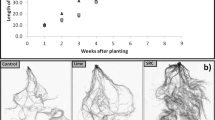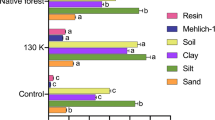Abstract
The effect of granite powder (<70µm) as a K fertilizer was investigated in a glasshouse pot experiment conducted with three acid, sandy topsoils from podzols of South Western Australia and with three fertilizer treatments: a control without K application, a KCl treatment (90 mg K kg−1 soil) and a granite treatment (20 g granite kg−1 soil, yielding 640 mg K kg−1 soil). Subterranean clover (Trifolium subterraneum) and ryegrass (Lolium rigidum) were cropped in triplicated pots for 7 weeks, harvested and allowed to regrow for another 13 weeks. Clover growth at 7 weeks was in the following order: control < granite < KCl. The growth of ryegrass after 7 weeks was not significantly affected by granite as compared to the control treatment. After another 13 weeks, both species showed a significant growth response to granite application for two of the three soils studied. For both species and all three soils K concentrations in the plant tissue were systematically and significantly higher for KCl relative to granite and for granite relative to control treatment. Minor dissolution of granite occurred during the short duration of the experiment as indicated by changes in soil exchangeable K in uncropped pots (about 1-2% of K applied) and resulted in the increased K concentration in plants and the growth response of subterranean clover after 7 and 20 weeks and ryegrass after 20 weeks of cropping. The possible use of granite powder as a slow-release K fertilizer is discussed.
Similar content being viewed by others
References
A.O.A.C. (1975) Official Methods of Analysis, 13th Edn. AOAC, Washington DC, USA
Baerug R (1991a) Rock powder as a source of nutrients to different crops. The effect of potassium in rock powder. Norsk Landbruksfors 5:175–181
Baerug R (1991b) Rock powder as a source of nutrients to different crops. The magnesium effect of rock powder. Norsk Landbruksfors 5:183–188
Barrow NJ (1985) Comparing the effectiveness of fertilisers. Fert Res 8:85–90
Blum WEH, Herbinger B, Mentler A, Ottner F, Pollak M, Unger E & Wenzel WW (1989a) Zur Verwendung von Gesteinsmehlen in der Landwirtschaft. I. Chemisch-mineralogische Zusammensetzung und Eignung von Gesteinsmehlen als Düngemittel. Z Pflanzenernäh Bodenkd 152:421–425
Blum WEH, Herbinger B, Mentler A, Ottner F, Polak M, Unger & Wenzel WW (1989b) Zur Verwendung von Gesteinsmehlen in der Landwirtsctaft. II. Wirkung von Gesteinsmehlen als Boden-verbesserungsmittel. Z Pflanzenernähr Bodenkd 152:427–430
Blockman OC, Kaarstad O, Lie OH & Richards I (1990) Agriculture and Fertilizers. Fertilizers in Perspective. Norsk Hydro a.s. Publish., Norway. 245 p
Chesworth W, van Straaten P & Semoka JMR (1989) Agrogeology in East Africa: the Tanzania-Canada project. J. Afr. Earth Sci. 9:357–362
Delvaux B, Herbillon AJ, Dufey JE & Vielvoye L (1990a) Surface properties and clay mineralogy of hydrated halloysite soil clays. I. Existence of interlayer specific sites. Clay Miner. 25: 129–139
Delvaux B, Herbillon AJ, Dufey JE & Vielvoye L (1990b) Surface properties and clay mineralogy of hydrated halloysite soil clays. I. Evidence for the presence of halloysite/smectite (H-Sm) mixed-layer clays. Clay Miner. 25:141–160
Gilkes RJ & Young RC (1974) Artificial weathering of biotite. III Potassium uptake by subterranean clover. Soil Sci Soc Amer Proc 38:41–43
Gillman GP (1980) The effect of crushed basalt scoria on the cation exchange properties of a highly weathered soil. Soil Sci Soc Am J 44:465–468
Gillman GP, Bristow KL & Hallman MJ (1989) Leaching of applied calcium and potassium from an oxisol in humid tropical Queensland. Aust J Soil Res 27:183–198
Hinsinger P & Jaillard B (1993) Root-induced release of interlayer potassium and vermiculitization of phlogopite as related to potassium depletion in the rhizosphere of ryegrass. J Soil Sci 44:525–534
Hinsinger P, Jaillard B & Dufey JE (1992) Rapid weathering of a trioctahedral mica by the roots of ryegrass. Soil Sci Soc Am J 56:977–982
Hinsinger P, Bolland MDA & Gilkes RJ (1996) Silicate rock powder: effect on selected chemical properties of a range of soils from Western Australia and on plant growth as assessed in a glasshouse experiment. Fert Res (In press)
Hughes JC & Gilkes RJ (1984) The dissolution of North Carolina phosphate rock in some south-western Australian soils. Fert Res 38:249–253
Kahnt G, Pfleiderer H & Hijazi LA (1986) Wirkungen meliorativer Gaben von Gesteinsmehlen und Gesteinssanden auf das Wachstum verschiedener landwirtschaftlicher Kulturpflanzen sowie auf physikalische Kennwerte eines Sandbodens und eines Tonbodens. J Agron Crop Sci 157:169–180
Mc Arthur WM (1991) Reference Soils of south-western Australia. Australian Society of Soil Science, Western Australian Branch, Perth, Australia. 265 p
Mortland MM, Lawton K & Uehara G (1956) Alteration of biotite to vermiculite by plant growth. Soil Sci 82:477–481
Nahon DB (1991) Introduction to the petrology of soils and chemical weathering. John Wiley and Sons, New York, USA. 313 p
Pieri C & Oliver R (1986) Assessment of K losses in tropical cropping systems of Francophone Africa and Madagascar. In: Proceedings of the 13th Congress of the International Potash Institute, International Potash Institute, Bern, Switzerland
Reuter DJ & Robinson JB (1986) Plant analysis: an interpretation manual. Inkata Press, Melbourne, Australia, 218 p
Sanz Scovino JI & Rowell DL (1987) The use of feldspars as potassium fertilizers in the savannah of Colombia. Fert Res 17:71–83
Singh B & Gilkes RJ (1991) A potassium-rich beidellite from laterite pallid zone in Western Australia. Clay Miner 26:233–244
Snowball K & Robson AD (1993) Symptoms of nutrient deficiencies: Subterranean clover and wheat. Department of Soil Science and Plant Nutrition, University of Western Australia, Nedlands, Australia, 72 p
Von Fragstein P, Pertl W & Vogtmann H (1988) Verwitterungsver-halten silikatischer Gesteinsmehle unter Laborbedingungen. Z Pflanzenernähr Bodenkd 151:141–146
Weerasuriya TJ Pushpakumara S & Cooray PI (1993) Acidulated pegmatitic mica: a promising new multi-nutrient mineral fertilizer. Fert Res 34:67–77
Wong MTF, Van der Kruijs ACBM & Juo ASR (1992) Leaching loss of calcium, magnesium, potassium and nitrate derived from soil, lime and fertilizers as influenced by urea applied to undisturbed lysimeters in south-east Nigeria. Fert Res 31:281–289
Author information
Authors and Affiliations
Rights and permissions
About this article
Cite this article
Coroneos, C., Hinsinger, P. & Gilkes, R.J. Granite powder as a source of potassium for plants: a glasshouse bioassay comparing two pasture species. Fertilizer Research 45, 143–152 (1995). https://doi.org/10.1007/BF00790664
Received:
Accepted:
Issue Date:
DOI: https://doi.org/10.1007/BF00790664




